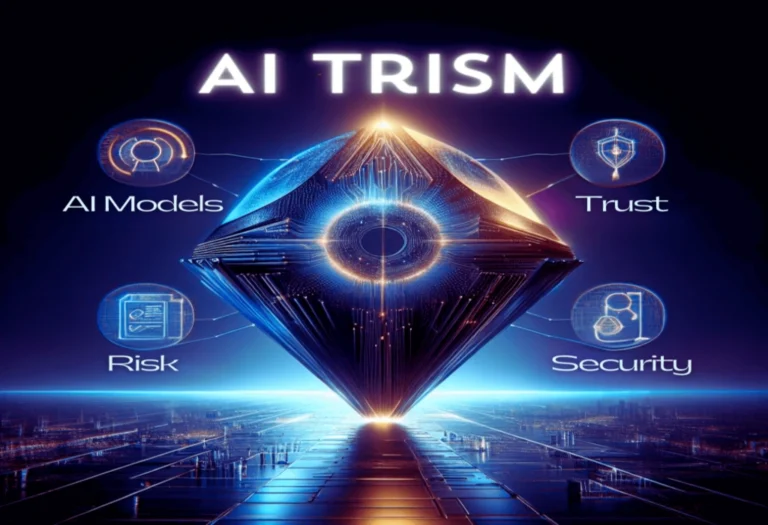Exploring AI Models: A Quick Dive into Trust, Risk, and Security using the AI TRiSM Framework
Introduction
AI Artificial intelligence promises immense potential in transforming businesses and enhancing human capabilities across industries. However, as AI becomes more powerful and prevalent, concerns around trust, ethics, reliability, and security have heightened. Several high-profile cases of AI failures, data breaches, and model vulnerabilities have already surfaced. This necessitates a comprehensive approach to governing AI – integrating checks and balances to ensure its safe, reliable and compliant use.
AI TRiSM: AI Trust, Risk, and Security Management. an emerging framework designed specifically to tackle these challenges within AI systems. By integrating governance directly into the machine learning pipeline, AI TRiSM aims to guarantee certain desired properties in AI models:
What is AI trust, risk and security management
- Trustworthiness – Ensuring model behavior aligns with expectations around fairness, transparency and ethics
- Reliability & Robustness – Building robust models that provide consistent, accurate results as per their objectives
- Security – Safeguarding confidential data as well as detecting and protecting models against adversarial attacks
- Privacy – Upholding data regulations and keeping private data compartmentalized
The AI TRiSM methodology comprises proactive measures across four key pillars – explainability, operations, security and privacy. It emphasizes constant monitoring, tailored controls and risk management practices to uphold standards throughout the AI model’s lifecycle.
Understanding AI TRiSM
Before exploring AI TRiSM’s pillars and impact, let’s build a foundational understanding of this methodology.
What is AI TRiSM?
AI TRiSM or AI Trust, Risk and Security Management refers to the entire lifecycle process of optimizing AI systems for trustworthiness, reliability, safety and compliance. It emphasizes proactive governance based on continuous monitoring and control of risks that may undermine these objectives.
Origins and History
The concept of AI TRiSM was formally introduced in 2020 by technology research firm Gartner, although similar ideas around ethical AI governance existed earlier. It gained rapid traction as businesses recognized the growing imperative of accountability and transparency in AI systems.
Key milestones in AI TRiSM’s advancement include:
- 2021 – The EU proposes the AI Act, incorporating concepts of trustworthy AI
- 2022 – Denmark launches an AI TRiSM program for fintech
- 2023 – 50% of large enterprises are predicted to implement AI TRiSM
How AI TRiSM Works
At its core, AI TRiSM relies on constantly evaluating risks across data, models and AI applications using customized assessments. Controls are then implemented through policies, model architecture strategies, and ongoing ops practices to mitigate these risks.
Let’s break this down further:
- AI TRiSM begins at the planning stage with clear objectives around trust and security
- Data collection, model development and application design choices align with these objectives
- Once the AI system is operational, multifaceted assessments reveal risks or gaps
- Tailored controls are continuously implemented to course-correct when gaps emerge
With a strong foundation on AI TRiSM laid out, let’s examine its central pillars that drive impact.
4 Pillars of AI TRiSM
AI TRiSM rests on four central pillars comprising a mix of technical and operational best practices:
A. Explainability/Model Monitoring
Explainability refers to techniques that clarify how AI models arrive at outputs or decisions. Monitoring refers to practices that evaluate model performance and behavior. Together, they offer visibility into:
- The underlying logic behind model functioning
- Training data composition and relevance
- Potential biases and inconsistencies
- Model strengths and limitations
- Likelihood of errors
Explainability and monitoring drive transparency and trust in AI by answering vital questions for developers and business users.
B. ModelOps
ModelOps involves comprehensive management of AI models post-deployment, including:
- Continuous model testing and monitoring
- Streamlined model retraining, updates and replacement
- Integrated risk management processes
- Ongoing model performance optimization
It requires a collaborative effort between data scientists, IT teams and business units with specialized ModelOps tools. This pillar ensures maintained reliability and accuracy of AI systems.
C. AI Application Security
This pillar deals with protecting AI applications and interfaces from vulnerabilities, including:
- Securing access to AI apps, especially cloud-based ones
- Safeguarding confidential data used by apps
- Detecting and stopping adversarial AI attacks
- Maintaining regulatory and data privacy compliance
AI app security is vital as businesses increasingly expose AI models to users via apps and web interfaces.
D. Privacy
The privacy pillar controls risks associated with data collection, storage and use – ensuring adherence to standards like GDPR. It involves data governance practices for:
- Anonymizing private data
- Encrypting data communications
- Restricting unauthorized data access
- Deleting data per retention policies
- Gaining user consent where required
With these pillars providing a strong foundation, let’s analyze AI TRiSM’s real-world impact.
Use Cases and Benefits of AI TRiSM
AI TRiSM delivers immense value across sectors by optimizing AI systems for reliability, security and compliance. Let’s explore some prominent use cases.
Supply Chain Optimization
Global manufacturer Flex implements AI to predict optimal production and inventory levels. By integrating AI TRiSM, Flex monitors data and model risks, explains predictions to users, and secures AI access – ensuring trust and minimizing losses from inaccurate demand forecasts.
Personalized Recommendations
Leading OTT platform Netflix uses AI to recommend personalized content to subscribers. AI TRiSM allows Netflix to secure subscriber data, monitor recommendations for bias, explain suggestions when contested, and continually improve model accuracy – driving engagement while building trust.
Healthcare Diagnosis
AI TRiSM proves invaluable in healthcare by explaining diagnosis decisions, monitoring model performance, and securing patient data privacy per regulations. One medical startup using this is Abzu, which creates AI models for breast cancer screening. Their AI TRiSM program ensures patient trust and safety.
These use cases highlight a few key generalized benefits applicable across sectors:
Key Benefits
- Increased model accuracy and performance optimization
- Reduced risk from data breaches or model manipulation
- Higher user trust and acceptance levels
- Smoother regulatory compliance
- Protection of brand reputation
By tackling risks proactively, AI TRiSM unlocks AI’s full potential responsibly. Now let’s examine some common snags.
Limitations and Risks of AI TRiSM
While AI TRiSM drives significant upside, it also poses some challenges:
Infrastructure Complexities
Implementing the four pillars requires re-engineering data infrastructure, model development workflows, app security architecture and privacy controls – involving considerable time and resources.
Shortage of Specialized Skill Sets
The specialized nature of AI TRiSM also necessitates teams skilled in data ops, MLOps, app sec, and privacy engineering – still rare skill sets today. Substantial training and hiring efforts may be needed.
Lack of Out-of-the-Box Tools
As an emerging discipline, there is a lack of readily available platforms or tools tailored specifically for AI TRiSM. Most solutions need custom development currently. Vendors are only now launching dedicated products.
Continuous Effort Mandated
AI TRiSM is not a one-time activity but requires recurring audits, updates to controls, and model re-development. The overhead can prove substantial if not planned well.
Evolving Best Practices
With regulations and security threats constantly evolving, AI TRiSM practices also need regular revision to keep pace. Keeping updated itself poses overhead.
By anticipating these snags, organizations can size the effort appropriately and accelerate their AI TRiSM journey.
Now let’s discuss recommendations for executing AI TRiSM programs.
Implementing an AI TRiSM Program
Executing an enterprise-wide AI TRiSM strategy requires coordinated efforts across teams, guided by leadership commitment. Here are key recommendations:
Set Up a Task Force
Assemble an AI TRiSM team spanning data, engineering and compliance leaders. This cross-functional unit can conduct assessments, derive requirements, and drive adoption.
Involve Diverse Experts
Actively consult external advisors like ethicists, cybersecurity firms, and legal partners when designing controls to boost effectiveness. Diverse perspectives enrich AI TRiSM programs.
Prioritize Explainability
Explainable and interpretable AI builds user trust and transparency vital for success. Invest in techniques like LIME, SHAP, decision trees early on.
Tailor Methods to Use Cases
Customize controls and tools based on specific model use cases and components vs. taking a blanket approach. Precision targeting enhances outcomes.
Ensure Data/Model Integrity
Incorporate data ops, MLOps and rigorous model evaluation practices to maintain regulatory compliance, fairness and reliability of AI systems.
With sustained rigor and commitment to these principles, businesses can transform AI TRiSM into a key competitive advantage.
Now let’s envisage what lies ahead.
The Future of AI TRiSM:
As AI becomes further entrenched across industries, AI TRiSM will likely see rapid innovation and adoption over the next decade. Here are some key predictions:
Sophisticated Tools and Platforms
Vendors will launch tailored platforms encompassing data governance, MLOps, app sec, and privacy tools – accelerating AI TRiSM implementation.
Emerging Best Practices
With increasing adoption, consensus will emerge around leading standards, architectures, and policy frameworks constituting AI TRiSM.
Tighter Integration with ML Lifecycle
AI TRiSM processes will become ingrained into model development, management and monitoring workflows – no longer an afterthought.
More Skilled Practitioners
Specializations like Trust & Ethics Architects will arise to implement and enhance AI TRiSM programs as their necessity is recognized.
Stricter Regulations
As risks related to uncontrolled AI deployment rise, policymakers will enact regulations mandating AI TRiSM to uphold user and societal interests.
Mainstream Adoption
By 2030, AI TRiSM is predicted to become integral to responsible AI adoption for most organizations – ushering an era of reliable, ethical and secure AI.
The future certainly looks promising for AI TRiSM’s maturation into a governance pillar supporting cutting-edge innovation in AI.
Conclusion
As AI capabilities advance, businesses must equally prepare for emerging risks like biased outputs, data breaches and malicious attacks that can undermine objectives. AI TRiSM offers a comprehensive methodology to embed trust, reliability, security and privacy by design into AI systems.
By integrating checks and balances across four pillars – Explainability, Operations, Security and Privacy – AI TRiSM governance minimizes downside risks while optimizing value. It enables transparent model behavior, continual performance improvements, regulated data practices and resilience against AI threats.
Early adopters are already demonstrating smooth regulatory compliance, strong competitive advantage, and increased returns on AI investments.
As regulations evolve and users demand responsible AI, organizations must invest in AI TRiSM as a key pillar for sustaining business success. The framework provides the foundations for ethical, safe and highly impactful AI systems poised to transform industries. Prioritizing its adoption will be the hallmark of AI trailblazers of the future.
TL;DR
AI TRiSM (Trust, Risk and Security Management) is an emerging framework designed to optimize AI systems for trustworthiness, reliability, safety and regulatory compliance. By integrating checks and balances across four pillars – explainability, operations, security and privacy – AI TRiSM minimizes risks.
| Aspect | Description |
|---|---|
| Definition | AI TRiSM optimizes AI for trust, reliability, safety, and compliance, integrating governance in the machine learning pipeline. |
| Objectives | Ensures ethical AI behavior, builds robust models, safeguards data, and upholds privacy regulations. |
| Methodology | Proactively manages AI risks through four pillars: Explainability, Operations, Security, and Privacy. |
| Pillars | Clarifies model outputs, comprehensive post-deployment management, secures AI apps, and controls data privacy risks. |
| Use Cases | Monitors risks for accurate predictions, secures data, ensures patient privacy in healthcare diagnosis. |
| Benefits | Increases model accuracy, reduces risks, builds trust, ensures compliance, and protects brand reputation. |
| Limitations/Risks | Requires infrastructure changes, demands specialized skills, lacks out-of-the-box tools, mandates continuous effort, and evolves best practices. |
| Implementation Tips | Assemble a cross-functional task force, consult diverse experts, prioritize explainability, tailor methods to use cases, and ensure data/model integrity. |
| Future Predictions | Expects sophisticated tools, emerging best practices, tighter integration with ML lifecycle, more skilled practitioners, stricter regulations, and mainstream adoption. |
And with that, we conclude our exploration of AI TRiSM and its immense potential. If you’re interested in enhancing your AI’s resilience to potential threats, you might want to explore our post on D.I.S: How a Digital Immune System Fortifies Your Digital Assets. Stay tuned for more insights on AI, Until next time, Stay Savvy

